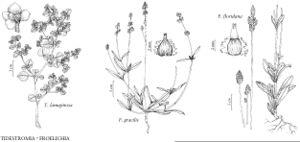Difference between revisions of "Tidestromia"
J. Wash. Acad. Sci. 6: 70. 1916.
imported>Volume Importer |
(No difference)
|
Latest revision as of 08:42, 30 July 2020
| Taxon | Illustrator ⠉ | |
|---|---|---|
 | Tidestromia lanuginosa Froelichia gracilis Froelichia floridana | Yevonn Wilson-Ramsey Yevonn Wilson-Ramsey Yevonn Wilson-Ramsey |
Herbs or subshrubs, annual or perennial, densely pubescent or glabrous, rhizomatous. Stems ascending, decumbent, or prostrate, herbaceous or suffrutescent, usually bearing buds at base in perennial species. Leaves: distal leaves opposite, proximal leaves sometimes alternate, sessile or petiolate; blade lanceolate to circular, chartaceous to fleshy, base attenuate, cuneate, cordate, or oblique, margins entire, apex acute to obtuse. Inflorescences axillary, sessile dichasium, subtended by 2 subopposite, involucral leaves that become indurate and connate in age. Flowers bisexual, sessile or short-pedicellate; tepals 5, distinct, keeled, inner 2 distinctly shorter than outer 3, scarious or coriaceous, base cuneate, margins entire or distally crenate, apex acute or obtuse [aristate], glabrous or lanuginose; trichomes completely and partially candelabriform or with random projections [barbed]; stamens 5; filaments connate at base into low cups, usually equal; anthers 2-locular; pseudostaminodes triangular short lobes [linear, equalling filaments] or absent; staminodes present or absent; ovule 1, membranous; styles absent or short; stigmas 2-fid or seldom irregularly 3-fid (in var. oblongifolia), deltoid. Utricules subglobose, proximally membranous, distally hyaline, indehiscent. Seeds 1, brown-red or white, obovoid. x = 10.
Distribution
North America, n Mexico, West Indies
Discussion
Species 6 (3 in the flora).
Tidestromia species traditionally have been characterized by habit, texture, pubescence, forms of tepal trichomes, and size of pseudostaminodes. The phyllotaxy of Tidestromia has been the source of some confusion. It has been characterized as opposite (C. F. Reed 1970; K. R. Robertson 1981; F. Shreve and I. L. Wiggins 1964; P. C. Standley 1917b) or alternate to opposite in proximal leaves and opposite or whorled in threes in distal leaves (J. Henrickson 1993). Detailed observations show that three leaves are commonly present nearly at the same node; one of these leaves is the true leaf with alternate phyllotaxy, and the other two are subopposite involucral leaves. The inflorescences are usually described as glomerules (D. S. Correll and M. C. Johnston 1970; U. H. Eliasson 1988; K. R. Robertson 1981; F. Shreve and I. L. Wiggins 1964; P. C. Standley 1916c, 1917b; I. L. Wiggins 1980). They are in fact dichasia surrounded by involucral leaves and, sometimes, a true leaf.
The morphology of the involucrelike structures surrounding the fruits are taxonomically useful, especially those located on secondary branches. They are formed in two ways. In the first, the involucres in fruit are composed of either the stem and the petioles of the two involucral leaves, or the stem, the petioles of the two involucral leaves, and the petiole of a true leaf. In the second, the involucres in fruit are composed of either the bases of the two involucral leaves or the bases of the two involucral leaves and base of the true leaf, but never with the stem. The involucres in fruit on secondary branches can be recognized because they separate as a single unit of dispersion.
Selected References
None.
Key
| 1 | Plants perennial subshrubs; buds present on stem bases, rarely absent | Tidestromia suffruticosa |
| 1 | Plants annual herbs; buds absent on stem bases | > 2 |
| 2 | Leaf blades usually chartaceous, gray-green, canescent, lanuginose, or glabrous; involucral leaf petioles adnate with stems, or with leaf petioles and stem, into involucres on secondary branches | Tidestromia lanuginosa |
| 2 | Leaf blades fleshy, membranous when dry, yellowish green, glabrous or nearly so; involucral leaf bases connate and sometimes adnate with leaf bases into involucres on secondary branches | Tidestromia carnosa |